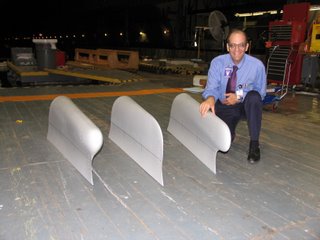Model Testing at Carderock

Last week, I think it was Sept. 18 or 19, I spent an afternoon at the David Taylor Model Basin (formally, the Naval Surface Warfare Center Carderock Division). The picture shows me in the model assembly area for Carriage 2, right inside the eastern end of the tank. The name, "David Taylor Model Basin", is on the outside of this wall and can be seen from the Capital Beltway near the American Legion Bridge across the Potomac. The facility was erected about the time of World War II to replace the smaller Experimental Model Basin (EMB) where Admiral Taylor (the David Taylor of the facility name) did his tests in the 1890's and early 1900's.
It's an amusing reflection of today's technology that computer modelling has so far failed to replace tank testing as a means of predicting ship resistance. I was at DTMB to watch a test of a hull I had designed, a fast cargo ship. It was tested with 4 alternative bows (three of them are beside me on the floor; the fourth is on the model, not shown in the picture). This was a very large model, about 30 feet long, and beautifully made by the DTMB model shop, of fiberglass with an internal subframe of welded aluminum that served as pickup points for the bolts that held the swappable bows in place, as well as for the instruments and towing equipment. Both the hull shapes and the alignment of the bows were precision.
Note the studs along the sides of the bows. These are to trip the flow from laminar to turbulent to better model the full scale flow. When Admiral Taylor (the David Taylor of the facility name) did his series of model tests around 1900, later to be published as Speed and Power of Ships (1910) with several subsequent editions, he concluded that his 20 foot models required no turbulence stimulators, but today's "Tank Rats" disagree, even for the largest models. (My most successful design, AOE 6, was tested in the mid 1980's with only a 20-foot model.) DTMB is one of the largest testing tanks in the world. Results of model tests, especially of small variations to a model, benefit from having the largest model possible to reduce scale effects.
